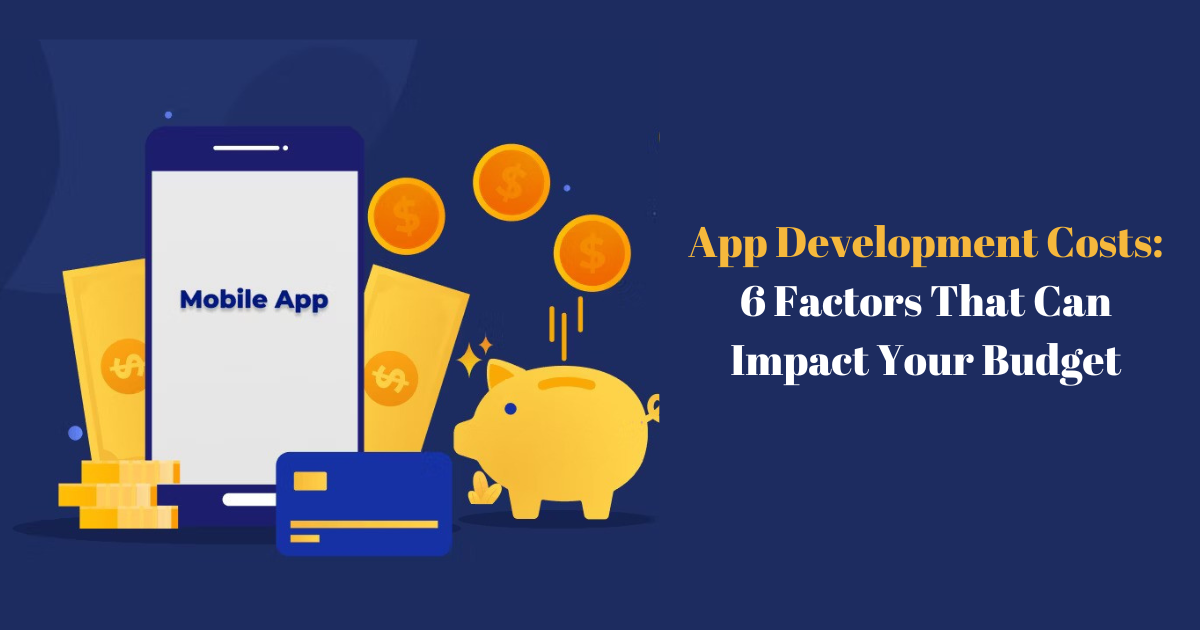App Development Costs: 6 Factors That Can Impact Your Budget!
In today’s digital age, businesses are increasingly recognizing the importance of having a mobile app. Whether it’s to engage customers, improve internal operations, or enhance brand visibility, mobile apps offer immense value. However, when it comes to app development, understanding the associated costs can be a challenge for many. There are multiple factors that can influence the final budget of an app project, and being aware of them can help businesses make informed financial decisions.
In this article, we’ll explore six key factors that impact app development costs and provide you with a clear understanding of what you need to consider when planning your app budget.
1. App Complexity
The first and most significant factor affecting app development costs is the complexity of the app itself. The more complex an app, the more expensive it is to develop. App complexity can be broken down into three main categories: simple apps, moderately complex apps, and highly complex apps.
- Simple Apps: These apps typically have a few core features and limited screens. Examples include a basic calculator or a simple to-do list app. Development time for simple apps is usually shorter, making them more budget-friendly.
- Moderately Complex Apps: These apps have more features and often involve user login functionality, data storage, and some level of API integration. A typical example might be a fitness tracker app that syncs with a wearable device. The development time for such apps is longer, which increases the cost.
- Complex Apps: These apps are feature-rich, involving advanced functionalities like real-time data synchronization, extensive backend systems, and multi-user platforms. Examples include e-commerce platforms or social media apps. Due to the higher level of expertise and time required, these apps come with a higher price tag.
Cost Impact: As the app’s complexity increases, so do the number of resources and the amount of time needed for development. Complex apps require more developers, designers, and testers, all of which drive up the costs.
2. Platform Selection (iOS, Android, or Both)
Another key factor influencing app development costs is the platform on which the app will be built. Businesses need to decide whether to build their app for iOS, Android, or both platforms. Each platform has its own development environment, which affects the complexity and cost.
- iOS vs. Android: Developing an app for iOS involves coding in Swift, whereas Android development requires Java or Kotlin. While the design principles may be similar across platforms, the coding requirements differ, which means developers must adapt their approach accordingly. In general, Android app development can take longer due to the wider variety of devices and screen sizes it needs to accommodate.
- Cross-Platform Development: Many businesses opt for cross-platform development using tools like React Native or Flutter, which allow apps to run on both iOS and Android with a single codebase. While this can reduce development time, it’s important to note that cross-platform development may still require platform-specific adjustments, particularly for complex apps.
Cost Impact: Building an app for a single platform will be cheaper than building for both iOS and Android. However, targeting both platforms can broaden your reach, potentially offering a better return on investment (ROI) despite the higher initial cost.
3. Design Requirements
Design plays a crucial role in app development and directly impacts the overall cost. A well-designed app provides a better user experience, which is essential for success in a competitive market. However, design requirements can vary depending on the complexity and customization desired.
- Basic Design: Apps with a basic user interface (UI) are simpler and quicker to design. These apps focus on functionality over aesthetics and usually involve standard templates with minimal customization.
- Custom Design: Custom designs involve creating unique, visually appealing interfaces tailored to the brand’s identity. These designs often include advanced animations, transitions, and graphics that require a higher level of expertise and time.
Cost Impact: Custom designs that prioritize the user experience and brand differentiation tend to be more expensive. Investing in a well-thought-out design can boost user retention and engagement, making it a valuable long-term investment.
4. Development Team’s Expertise
The skill and experience level of the app development team can have a major impact on costs. You can either build an in-house team, hire freelance developers, or outsource the development to an agency. Each option has its own cost implications.
- In-House Team: Hiring an in-house development team gives you full control over the project. However, it comes with overhead costs such as salaries, benefits, and infrastructure. This is a more expensive option, especially for smaller companies.
- Freelancers: Freelance developers are a cost-effective option for smaller projects, but they might not always offer the consistency or support that agencies provide. Moreover, managing freelancers across different time zones or expertise levels can sometimes delay project timelines.
- Outsourcing: Many businesses choose to outsource their app development to agencies, especially those based in regions with lower development costs. Agencies often provide comprehensive services, from design to development to post-launch support, which can be more cost-effective in the long run.
Cost Impact: A highly experienced team will charge more, but they are likely to deliver higher quality work. Cheaper options may reduce upfront costs but could result in longer development times or lower quality, potentially increasing costs later in the form of fixes or upgrades.
5. App Maintenance and Updates
App development doesn’t end with the launch. Ongoing maintenance is required to keep the app running smoothly and up-to-date with the latest operating systems and device changes. Maintenance includes bug fixes, performance improvements, and updates for new features or enhancements.
- Bug Fixes and Security Updates: Regular maintenance is necessary to fix bugs and ensure that the app remains secure. This is especially important as mobile operating systems frequently update.
- Feature Updates: As user expectations evolve, you may need to add new features to your app. This requires additional development work, which adds to the long-term cost.
Cost Impact: Maintenance is an ongoing expense that should be factored into your overall budget. Failing to invest in regular updates can lead to a poor user experience, negatively affecting the app’s success.
6. Third-Party Integrations and Features
Many apps rely on third-party services to provide additional functionality, such as payment gateways, social media logins, or cloud storage. Integrating these services into your app adds convenience for users, but it also increases development costs.
- Popular Integrations: Common third-party integrations include in-app purchases, push notifications, and real-time messaging. Some apps may also require external APIs to connect with other services, such as Google Maps or analytics tools.
Cost Impact: While third-party integrations can enhance your app’s capabilities, they also add complexity and may involve ongoing subscription costs for services like cloud hosting or API usage.
Conclusion
When planning your app development budget, it’s essential to consider the various factors that impact costs. From the complexity of the app to the design, platform selection, and ongoing maintenance, each decision can significantly affect the final price. Understanding these factors allows businesses to allocate resources effectively and set realistic expectations for the development process.
By working closely with an experienced apo development team and planning for future updates and maintenance, you can ensure that your app project stays on track and within budget while delivering the best possible experience for users.






